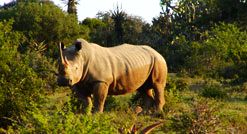
Wildlife Poachers to be taken down in South Africa
by Janine Erasmus South Africa’s environmental affairs department is to launch a new crack squad, known as the National Wildlife Reaction Unit, to tackle ongoing rhino poaching, and other matters relating to care of the environment. The formation of the elite unit was announced in April 2010 by Water and Environmental Affairs Minister Buyelwa Sonjica […]

by Janine Erasmus
South Africa’s environmental affairs department is to launch a new crack squad, known as the National Wildlife Reaction Unit, to tackle ongoing rhino poaching, and other matters relating to care of the environment.
![[Image]](http://mediaclubsouthafrica.com/images/stories/april2010/rhino-text.jpg)
A budget of R2-million (US$268 415) has been set aside for the formation of the unit – this will be increased when necessary.
South Africa already has a dedicated and highly successful environmental watchdog in the form of the Environmental Management Inspectorate or Green Scorpions.
Formed in 2005, this countrywide network of inspectors, based in different government departments, works to flush out any contravention of environmental laws.
The new reaction unit will work alongside the Green Scorpions, boosting their work in rooting out the smuggling of animal parts.
Tackling environmental crime
In her National Environmental Compliance and Enforcement Report for 2008/09, released in November 2009, Sonjica revealed that 4 661 cases were reported and investigated during this period, and 2 412 criminal dockets were opened. This is a marked increased compared with the 1 762 dockets declared in the previous report.
Sonjica said that 2 547 arrests were made, although in just 258 cases a conviction was obtained. The meagre number of convictions compared with the higher number of dockets opened is said to be because of delays in the justice system.
More positively, the number of acquittals dropped sharply to 18, compared to 441 the year before, and the number of plea bargains also fell from 98 to four over the same period.
Furthermore, the number of registered green inspectors rose from 866 in 2008 to 903 in 2009, an increase of 4.3%. Of these, 70.2% work for the South African National Parks organisation. There are another 42 inspectors waiting in the wings – they have been trained but not yet deployed.
In her 2010 budget speech Sonjica announced more progress towards the re-opening of special environmental courts, saying that the number of related crimes reported during 2009 presented a strong case for their establishment.
Having committed herself to the project in her budget speech of 2008, Sonjica said that, with the assistance of Justice Minister Jeff Radebe, the first dedicated session for environmental crimes will take place in the Johannesburg Regional Court on 20 May 2010.
Similar schemes will be rolled out in other centres around the country, including Durban, Nelspruit, and Hermanus, followed by more locations as the need arises.
Sonjica said that some 300 prosecutors and 200 magistrates have received special training in anticipation of the new legal system.
Killed for their horns
However, not even thevigilant Green Scorpions are able to make inroads into the indiscriminate killing of rhinos by poachers looking for horns.
Sonjica attributed this directly to international crime syndicates supplying the hungry Middle and Far East markets. These criminal organisations have now set their sights on South Africa’s abundant rhino herds, and are suspected of infiltrating local game reserves and recruiting staff to locate and kill the animals.
Rhino horn is used in traditional Chinese medicine, although modern science has yet to confirm its purported miraculous properties. The horn is also popular in the Middle East, as it’s used to make intricate dagger handles.
In much of Africa rhino conservation efforts have been severely hampered by unrest, civil war and easy access to weapons.
“We are predicting that by the end of this year, there will be 163 [rhinos poached],” Sonjica said. “We are working with all of the security forces, as we are dealing with sophisticated mafia, from Asia, from all over the world.”
The Kruger National Park is still the main target, as poachers can easily slip across the Mozambique and Zimbabwe borders to find their quarry. Parks in KwaZulu-Natal province are also in the criminals’ sight, and recent reports have revealed that they have started to poach in parks in other provinces as well.
Deputy director in the branch of biodiversity and conservation, Fundisile Mketeni, said that his department would work with Interpol to clamp down on the illegal international trade.
Success story
Despite the poaching problem, South Africa’s rhino conservation project has been remarkably successful, especially in terms of the white rhino (Ceratotherium simum), listed as near threatened on the red list of the International Union for the Conservation of Nature.
By the middle of the 20th century there were just a few hundred white rhino left in the South African wild, but strict conservation measures brought the numbers up to around 11 000, making it now the most plentiful rhino species in the world.
Conservationists are still fighting to save the critically endangered black rhino (Diceros bicornis), whose numbers were estimated at around 1 470 in South Africa in 2007, compared with just 630 in 1980.
However, rhino populations are decreasing in general across Africa, prompting a need for swift and decisive action to stop the decline.